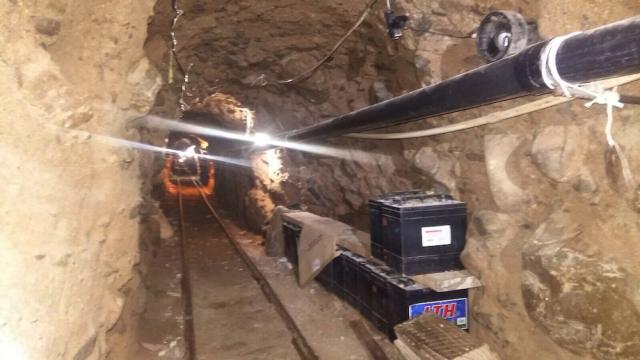So say you need to get a few hundred kilograms of cocaine from Mexico to the US. Underground, preferably, so as not to attract too much attention. Where’s the best place one might, hypothetically, do this? Asking for a friend.
Of the 27 drug tunnels discovered in raids along the California-Mexico border over the last 10 years, almost all of them terminate in a single San Diego suburb named Otay Mesa. This includes the longest drug tunnel ever discovered, which was busted just last week: a 795m-long, 90cm-diameter work of infrastructural art which ran from an elevator shaft in Tijuana to the parking lot of a fake pallet business on the US side. The US Department of Justice discovered 5003kg of marijuana and 1017kg of cocaine — the largest single-seizure cocaine bust in Southern California tunnel history.
What makes the Otay Mesa neighbourhood such a prime destination for drug-running? It’s not a lapse in local law enforcement. It’s the soil.
Otay Mesa seen on Google Maps and on a California Geologic Survey map. Use the slider to navigate between them
Otay Mesa is about 16km inland from the Pacific, but not too close to the nearby San Ysidro Mountains, making it perfect for digging. If the ground is too close to the ocean, it’s too wet, increasing the risk of flooding or collapse (although local groundwater aquifers still must be avoided). Closer to the mountains, the ground is too hard and can’t easily be excavated. The thin plume of sandy, rocky soil made from Pliocene marine deposits and volcanic ash fall that stretches from Otay Mesa to the area around the Tijuana airport — named Garita de Otay — is juuuuust right.
As Pat Abbott, geology professor at San Diego State University, tells the Los Angeles Times, “It’s really the ideal place for a tunnel. It’s quite easy to dig through. You could do it with a pickax.”
In addition to sharing optimal geologic conditions, both Otay Mesa and Garita de Otay are blessed with another similarity that connects them both above and below ground. The neighbourhoods are both filled with industrial businesses where the act of digging a tunnel wouldn’t be out of place. And as Monte Reel explains in this New Yorker story on drug tunnels, there doesn’t seem to be much oversight on who is moving in:
The amount of warehouse space in Otay Mesa has nearly quadrupled since the mid-nineties, and the expansion has been almost as frenetic in Garita de Otay. Forklifts, jackhammers, and heavy vehicles attract little attention. Cartel trucks back into loading bays, pallets are loaded in, and the drugs are delivered north to distribution hubs. There are three official border crossings near Otay Mesa; one, for commercial vehicles, is inside the industrial zone. “All of this has created a candy store for smugglers,” a U.S. agent told me. “This whole area belongs to them.”
You’d think that the combination of known geological factors plus the industrial use would mean that the DEA would be constantly swarming the lots, preventing any new tunnels from being dug.
Or maybe, maybe, since the feds know that the tunnels can only be dug in such a narrow sliver of real estate, they’re quietly focusing their efforts here, letting the drug runners move in and dig away, then preparing for the next round of whack-a-mole.
Top: A tunnel discovered in the Otay Mesa area in 2015. Mexico Federal Police via AP
